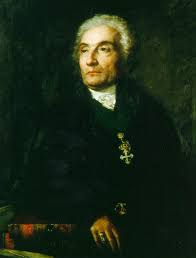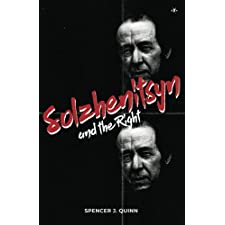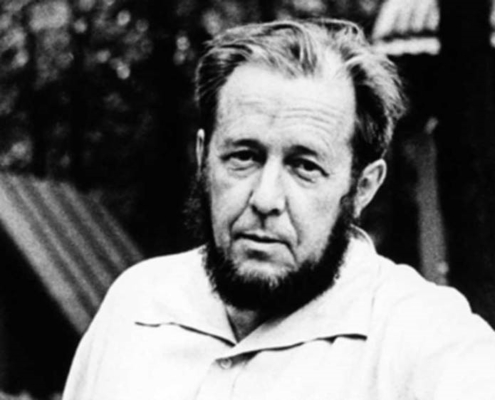Evil Genius: Constructing Wagner as Moral Pariah—PART 1
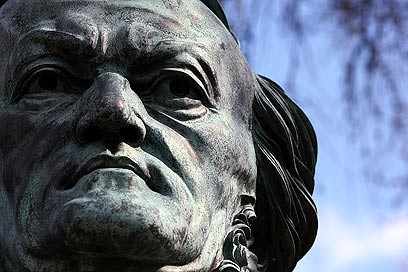
Note: This is a greatly expanded and updated version of an essay that first appeared on TOO in 2012.
A long line of books and documentaries have explored Richard Wagner’s anti-Semitism and his putative role as the spiritual and intellectual godfather to Adolf Hitler. In the Jewish-dominated cultural milieu of the contemporary West, this meme has taken on such a life that Wagner’s name is seldom mentioned today without the obligatory disclaimer that, while admittedly (and unfortunately) a musical genius, his reputation is forever sullied by his standing as a morally-loathsome anti-Semite. A consequence of this is that, for many people, Wagner “has become symbolic of everything evil in the world.”[1]
Richard Wagner was a one-man artistic and intellectual movement whose shadow fell across all of his contemporaries and most of his successors. Other composers had influence; Wagner had a way of thinking named after him. A significant biographical feature of the composers that followed Wagner was how they grappled with his legacy. Some, like Bruckner and Strauss, imitated him; some, like Debussy and Bartok, rejected him; and some, like Hugo Wolf were almost paralyzed by the immensity of his achievement. Wagner’s influence extended to writers and intellectuals like Proust, Joyce, Lawrence, Mann, Baudelaire, Eliot, Nietzsche and Shaw. Given his huge impact on Western culture, Bryan Magee has strong grounds for his contention that “Wagner has had a greater influence than any other single artist on the culture of our age.”[2]
Wagner was a deeply polarizing figure in his lifetime, and no other composer has provoked such extreme antipathy or adulation. It has been said that his music has been loved and hated more immoderately than that of any other composer. Wagner was notoriously unscrupulous in his personal life—but his sexual and financial misdemeanors pale into insignificance beside the vastness and originality of his compositions. Even the anti-Wagnerites have had to acknowledge the enormity of his achievement, and his most fanatical detractors (a great many of them Jewish) have reluctantly agreed with the Russian composer Tchaikovsky, who wrote of the Ring: “Whatever one might think of Wagner’s titanic work, no one can deny the monumental nature of the task he set himself, and which he has fulfilled; nor the heroic inner strength needed to complete the task. It was truly one of the greatest artistic endeavors which the human mind has ever conceived.”[3]
The essence of Wagnerian opera lies in the music which deepens and subtilizes the overt meaning of the storyline. Profound, far-reaching psychic changes are accomplished through the music with little or no help from the words, and Wagner’s oeuvre includes some of the most powerful scenes in all opera. Wagner’s music dramas are notable for their use of leitmotifs, musical phrases associated with an idea or character. Not simply accompanying the libretto, they reveal the subconscious feelings of the characters or anticipate what will happen later in the story. There is no one-for-one correspondence between a leitmotif and the concept, idea or emotion that is first attached to it. The leitmotif has a potential to develop—but to develop musically. Scruton observed how “by implanting the principal of musical development in the heart of the drama Wagner is able to lift the action out of the events portrayed on the stage, and to endow it with a universal, cosmic and religious significance.”
One hundred and forty years after his death, Wagner retains a cultural prominence that surpasses any of his contemporaries. The excellence of his music has ensured its popularity has never waned, and Wagner is still well represented on recordings, on radio, and in the theater. Wealthy Wagner devotees travel the world in pursuit of live performances of his fifteen-hour, four-night opera cycle, Der Ring des Nibelungen. Every year thousands still make a pilgrimage to the small Bavarian town of Bayreuth where in 1876 he inaugurated a festival devoted to his own music. The appeal of Wagner’s music, libretti and stagecraft have ensured his music dramas remain useful to opera companies around the world as a reliable income source, even in straitened economic times.
It is, however, Wagner’s standing as “a notorious anti-Semite,” and the intellectual establishment’s obsession with him on this basis, that has increasingly shaped his image in the popular consciousness. Wagner’s reputation is now so thoroughly tainted that one almost never encounters a serious examination of his ideas. For some, Wagner’s anti-Semitism diminishes or even invalidates his accomplishment as a composer. As the commentator Adrian Mourby noted: “The notion that artists don’t have to be as beautiful as the works they create is a commonplace now—except in the case of Wagner. ‘Judaism in Music’ is what has made him the unforgivable exception.”[4]
Judaism in Music
Kevin MacDonald observes in Separation and its Discontents that Richard Wagner is perhaps the best known intellectual who focused on the Jewish domination of culture.[5] Wagner first expounded on what he saw as the pernicious Jewish influence on German art and culture in his 1850 tract Das Judenthum in der Musik (usually translated as Judaism in Music or Jewishness in Music), which was published under pseudonym in 1850.[6] Wagner’s essay took up the theme of a previous article by Theodor Uhlig in the Neue Zeitschrift für Musik that was critical of the “Hebraic art taste” that Uhlig thought manifest in Jewish composer Giacomo Meyerbeer’s grand opera Le Prophète.
Wagner attempted in his essay to account for the “popular dislike of the Jewish nature,” and “the involuntary repellence possessed for us by the nature and personality of the Jews.” He concludes that Germans instinctively disliked Jews due to their alien appearance, speech and behavior, noting that “with all our speaking and writing in favor of the Jews’ emancipation [i.e., the result of German high-mindedness and dedication to abstract principles of human rights], we always felt instinctively repelled by any actual, operative contact with them.”[7] Wagner here simply stated an obvious fact: that Germans, like all other racial and ethnic groups, were ethnocentric, and this colored their interactions with a fiercely-competitive, immensely ethnocentric resident outgroup like the Jews. According to Wagner, “We are deliberately distorting our own nature if we feel ashamed to proclaim the natural revulsion aroused in us by Jewishness. … Despite our pretended liberalism we still feel this aversion.”[8]
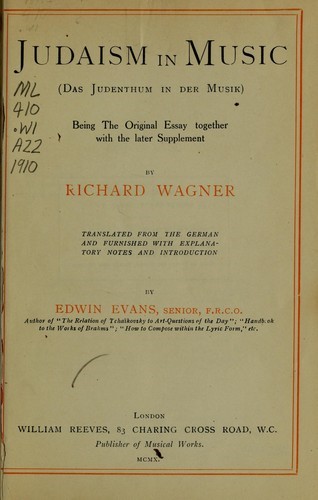 A 1910 English language edition of Judaism in Music
A 1910 English language edition of Judaism in Music
Wagner argued in Judaism in Music that Jewish musicians were only capable of producing music that was shallow and artificial because they had no connection to the genuine spirit of the German people. He observed that: “So long as the separate art of music had a real organic life-need in it down to the epochs of Mozart and Beethoven, there was nowhere to be found a Jewish composer. … Only when a body’s inner death is manifest, do outside elements win the power of lodgment in it—yet merely to destroy it.”[9] Jews had not fully assimilated into German culture, so did not identify with and merge themselves into the deepest layers of that culture, including its religious and ethnic influences—the Volksgeist. According to Wagner, “our whole European art and civilization … remained to the Jew a foreign tongue.” The Jews “through an intercourse of two millennia with European nations” had never fully abandoned the posture of “a cold, nay more, a hostile looker-on.” The entry of the Jews into nineteenth-century European society was, for Wagner, the infiltration of an alien and antagonistic group whose success symbolized the spiritual and creative crisis of German and European culture.
The same thesis was advanced by Zionist intellectuals like Ahad Ha’Am (the pseudonym of Asher Ginsburg). Kevin MacDonald notes that both Wagner and Ginsburg “developed the idea that Jews could not have their own artistic spirit because they failed to identify completely with the surrounding culture.”[10] In Wagner’s view, higher culture springs ultimately from folk culture. In the absence of Jewish influence, German music would once again reflect the deeper layers of German folk culture. For Wagner, “Judaic works of music often produce on us the impression as though a poem of Goethe’s, for instance, were being rendered in the Jewish jargon. … Just as words and constructions are hurled together in this jargon with wondrous inexpressiveness, so does the Jewish musician hurl together the diverse forms and styles of every age and every master. Packed side by side, we find the formal idiosyncrasies of all the schools, in motleyest chaos.”[11]
For Wagner, Jewish art was characterized by imitativeness, and therefore, by shallowness and superficiality. This was exemplified by the compositions that dominated the music scene of his time. From the depth and intensity of Bach, Mozart and Beethoven, the music of the concert hall had descended to the comparative superficiality of Mendelssohn—who had diverted the “tempests of revolution” into soothing salon music. Similarly, opera had fallen from the musical-dramatic peaks of Gluck and Mozart to the barren flatlands of Meyerbeer and Halevy. For Wagner, all that was meretricious in Grand Opera could be ascribed to the Jewishness of its composers—whose work amounted to a series of glib surface effects. He writes: “Of necessity what comes out of attempts by Jews to make art must have the property of coldness, of non-involvement, to the point of being trivial and absurd. We are forced to categorize the Jewish period in modern music as the period of consummate uncreativeness—stagnation run to seed.”
Writing in 1988, philosopher and cultural historian Bryan Magee observes that “to write works of this kind was to make use of art as a mere means—a means of entertainment, a means of giving pleasure and getting to be liked, a means of achieving status, money, fame. For Jews it was a means of making their way in an alien society.”[12] It certainly worked for Meyerbeer, with the first hundred performances of Le Prophète in Berlin alone netting him 750,000 marks—almost 200,000 marks more than the entire sum Wagner received over nearly two decades from his patron King Ludwig II of Bavaria.[13]
Wagner’s thesis has been roundly condemned by Jewish commentators, and yet the Jewish academic David Rodwin, while labelling Wagner’s essay “a vile anti-Semitic screed,” admits there is substantial truth in the “aesthetic eclecticism” that Wagner identified as a unifying feature of Jewish composers.[14] Regarding Wagner’s attribution of “imitativeness” as a particularly Jewish trait, Jacob Katz likewise acknowledges that: “Jewish qualities may quite naturally appear—for better or for worse—in artistic creations of Jews, even of those who have joined non-Jewish culture. It would therefore be preposterous to dismiss categorically all observations from the mouths of anti-Semites as prejudicial misconceptions.”[15] Magee calls Wagner’s thesis “unbelievably original” and notes:
One does not need to share Wagner’s view of Mendelssohn, who came from a Christianized and highly assimilated family, to see that his argument is substantially correct. … A really great creative artist is one who, in freely expressing his own needs, aspirations, and conflicts, articulates those of an entire society. This is made possible by the fact that, through his earliest relationships, mother tongue, upbringing, and all his first experience of life, the cultural heritage on which he has entered at birth is woven into the whole fabric of his personality. He has a thousand roots in it of which he is unaware, nourishing him below the level of consciousness, so that when he speaks for himself he quite unconsciously speaks for others. Now in Wagner’s time it was impossible for a Jewish artist to be in this position. The ghettos of Western Europe had only begun to be opened in the wake of the French Revolution, and their abolition was going on throughout the nineteenth century. The Jewish composers of Wagner’s day were among the very first emancipated Jews, pastless in the society in which they were living and working. They spoke its language with, literally, a foreign accent.[16]
According to Magee, Wagner failed to notice that he was describing a transitional phenomenon—that the creations of Jewish composers would inevitably become “deeper” and more culturally authentic as the descendants of emancipated Jews assimilated into their host societies. Magee cites the emergence of Mahler and Schoenberg in the late nineteenth century to illustrate his point.
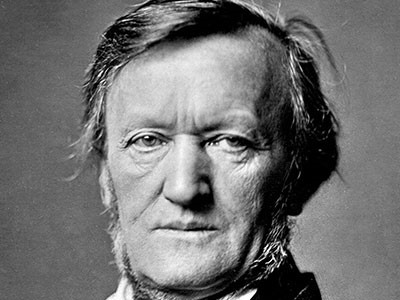 Richard Wagner
Richard Wagner
Drawing on the thesis of Heinrich Laube’s book Struensee, Wagner argued in Judaism in Music that Jews had also degraded German art by introducing their commercializing spirit into it. In February of 1848, at the funeral of Wagner’s mother, Laube had commiserated with his friend Wagner, equating the sadness of the hour with their mutual despair at the state of German art and culture, noting that “On the way to the station, we discussed the unbearable burden that seemed to us to lie like a dead weight on every noble effort made to resist the tendency of the time to sink into utter worthlessness.” As the preface to Struensee makes clear, this “worthlessness” consisted in the flowering of Jewish commercial values. Wagner’s only remedy was to “plunge dully and coldly into the only thing that could cheer me and warm me, the working out of my Lohengrin and my studies of German antiquity.”[17] Regarding the Jewish tendency to convert art into a branch of commerce, Wagner writes:
[All] is turned to money by the Jew. Who thinks of noticing that the guileless looking scrap of paper is slimy with the blood of countless generations? What the heroes of the arts … have invented … from two millennia of misery, today the Jew converts into an art-bazaar. … We have no need first to substantiate the Jewification [Verjudung] of modern art. It springs to the eye and thrusts upon the senses. … But if emancipation from the yoke of Judaism appears to us the greatest of necessities, we must hold it crucial above all to assemble our forces for this war of liberation. But we shall never gain these forces by merely defining the phenomenon [of Judaism] in an abstract way. This will be done only by accurately knowing the nature of that involuntary feeling of ours which utters itself as an instinctive repugnance against the Jew’s prime essence. … Then we can rout the demon from the field … where he has sheltered under a twilit darkness … which we good-natured humanists ourselves have conferred on him.[18]
For Wagner, Judaism was the embodiment of the bourgeois money-egoist spirit, and he observes that: “When our social evolution reached that turning-point at which the power of money to bestow rank began to be openly admitted, it was no longer possible to keep the Jews at bay. They had enough money to be admitted to society.” Wagner believed that Jews “will continue to rule as long as money remains the power to which all our activities are subjugated.” He later confessed to his fellow composer friend (and future father-in-law) Franz Liszt, “I felt a long-repressed hatred for this Jewish money-world, and this hatred is as necessary to my nature as gall is to blood. An opportunity arose when their damnable scribbling annoyed me most, and so I broke forth at last.”[19] In Judaism in Music Wagner finds the plea for Jewish emancipation to be “more than commonly naive, since we see ourselves rather in the position of fighting for emancipation from the Jews. The Jew is in fact, in the current state of the world, already more than emancipated. He rules.”
While stressing the harmful effects of the Jewish financial domination of German society, Wagner believed that the Jewish manipulation of language and art was infinitely more pernicious than their control over money. In his essay “What is German?” (1878, but based on a draft written in the 1860s) he states that culture, not economy, lies at the heart of German identity, and that Jews had bought the German soul and turned German Kultur into a sham, a mere image; and in doing this had destroyed “one of the finest natural dispositions in all the human race.”[20]
Wagner believed that the German people had been endowed with a uniquely rich inner life which had been forged during the crucible of the Thirty Years War. The body of the nation had almost been annihilated, “but the German spirit had passed through,” and amidst the physical ruins the Germans once again realized they were a nation of the spirit. This spirit had been preserved in the music of Johann Sebastian Bach, and the German spiritual mission in the world was to proclaim “that the Beautiful and the Noble came not into the world for sake of profit, nay, not for the sake of even fame and recognition.”[21] Wagner thus viewed the new festival theater he built in the Bavarian town of Bayreuth in 1876 as the Grail Castle of a reborn, spiritual Germany. Far from the cosmopolitan theaters owned and operated by city-dwelling Jews, Bayreuth would allow the German nation to regain a sense of its true self by experiencing the mythic force of its own ancient epic—the Nibelungen. Through Bayreuth, Wagner wanted to reclaim German art and culture from that “race of mediators and negotiators whose influence was … to spread its truly ‘international’ power more and more widely over Germany.”[22]
Wagner repeatedly observed (and lamented) the fact Jews had stormed the fortress of German high culture and had successfully “brought the public art-taste of our time between the busy fingers of the Jew.”[23] A host of Jewish middlemen had gained a hold over the critical press, publishing, theaters, operas, orchestras, art galleries and agencies. This Jewish cultural ascendancy in Germany was, of course, to reach its zenith in the Weimar Republic. Despite his stated views, Wagner twice refused to sign the “Anti-Semites Petition” of 1880 (presented to Bismarck) which complained about the very economic domination that so troubled him. The Petition, which quickly won 225,000 signatures, stated:
Wherever Christian and Jew enter into social relations, we see the Jew as master, the indigenous Christian population in a subservient position. The Jew takes part only to a negligible extent in the heavy labor of the great mass of the nation. But the fruits of his [the German’s] labor are reaped mainly by the Jew. By far the largest part of the capital which national labor produces is in Jewish hands. … Not only do the proudest palaces of our large cities belong to Jewish masters whose fathers and grandfathers, huckstering and peddling, crossed the frontiers into our fatherland, but rural holdings too, that most significant preservative basis of our political structure fall more and more into the hands of the Jews. … What we strive for is solely the emancipation of the German Volk from a form of alien domination which it cannot endure for any length of time.[24]
Cosima Wagner gave several explanations for her husband’s refusal to sign the petition, among them that he had already done as much as he could for the cause, that a petition he had signed against vivisection had failed, and that the new appeal was addressed in servile language to Bismarck, who by this time Wagner loathed.[25] Wagner deplored the “Jewishness” of the new German empire, which he thought, thanks to Bismarck, had turned out to be a real-politischer state, rather than a truly German one. In 1878, Wagner wrote that “Bismarck is creating German unity, but he has no conception of its nature. … His conduct is a disgrace for Germany … his decisions have brought forth from the Jews a petition of thanks.” When Bismarck spoke out against the Anti-Semites Petition it only confirmed Wagner in his conviction that Bismarck had “a pact with the Jews.”[26]
For Roger Scruton, central to Wagner’s genius was his determination to use his art to escape from the increasingly commercialized world of art he detested—a world “where value is price and price is value,” and where entertainment is considered more important than art. Wagner escaped “to a garret, high above the market place” in conscious reaction against the sentimentality and disingenuousness of the art and music at his time.
The operas of Wagner attempt to dignify the human being in something like the way he might be dignified by an uncorrupted common culture. Acutely conscious of the death of God, Wagner proposed man as his own redeemer and art as a transfiguring rite of passage to a higher world. The suggestion is visionary, and its impact on modern culture so great that the shockwaves are still overtaking us. … In the mature operas of Wagner our civilization gave voice for the last time to its idea of the heroic, through music that strives to endorse that idea to the full extent of its power. And because Wagner was a composer of supreme genius, perhaps the only one to have taken forward the intense inner language forged by Beethoven and to have used it to conquer the psychic spaces that Beethoven shunned, everything he wrote in his mature idiom has the ring of truth, and every note is both absolutely right and profoundly surprising.[27]
Wagner fled from the commercialized world of art into the inner realm of the imagination. He believed the idealism and heroism of a bygone age could be rekindled again. He strove to create a new music public that would not just identify with the Germanic heroic ideal, but embrace it as part of an idealistic nationalism that eschewed the bourgeois values of the mid-nineteenth century. In this endeavor, he strived to connect at an emotional rather than a rational level with his audience. As Wagner once wrote of his Ring cycle: “I shall within these four evenings succeed in artistically conveying my purpose to the emotional—not the critical—understanding of the spectators.”[28] This was in keeping with his dictum that art should be “the presentation of religion in a lively form.”
It was precisely this quality in Wagner’s works that most repelled the Frankfurt School music theorist and leading Wagner critic T.W. Adorno, who likened Wagner’s famous system of leitmotifs to advertising jingles in the way they imprinted themselves on the memory. For Adorno, Wagner’s musical innovations led to feelings of disorientation and intoxication that seduced audiences and rendered them docile and dangerously susceptible to political persuasion. In every crowd applauding a Wagnerian work, Adorno insisted, lurked “the old virulent evil” of “demagogy.” Elizabeth Whitcombe notes that
Adorno believed that Wagner’s work is “proselytizing” and “collective-narcissistic.” Adorno’s complaint about the “collective-narcissistic” quality of Wagner’s music is really a complaint that Wagner’s music appeals to deep emotions of group cohesion. Like the Germanic myths that his music was often based on, Wagner’s music evokes the deepest passions of ethnic collectivism and ethnic pride. In Adorno’s view, such emotions are nothing more than collective narcissism, at least partly because a strong sense of German ethnic pride tends to view Jews as outsiders—as “the other.” It is also not surprising that Adorno, as a self-consciously Jewish intellectual, would find such music abhorrent.[29]
Adorno’s jaundiced assessment of Wagner was encapsulated in Woody Allen’s quip that: “When I hear Wagner I have the irresistible urge to invade Poland.” Scruton points out that Wagner’s attempt to engage his audiences at the emotional level of religion (which so perturbed Adorno) was already doomed when Wagner first conceived it. The main problem being that:
[Wagner’s] sacerdotal presumptions have never ceased to alienate those who feel threatened by his message. Hence modern producers, embarrassed by dramas that make a mockery of their way of life, decide in their turn to make a mockery of the dramas [in so-called Regietheater/Eurotrash productions]. Of course, even today, musicians and singers, responding as they must to the urgency and sincerity of the music, do their best to produce the sounds that Wagner intended. But the action is invariably caricatured, wrapped in inverted commas, and reduced to the dimensions of the television sitcom. Sarcasm and satire run riot on the stage, not because they have anything to prove or say in the shadow of this unsurpassably noble music, but because nobility has become intolerable. The producer strives to distract the audience from Wagner’s message, and to mock every heroic gesture, lest the point of the drama should finally come home.
As Michael Tanner has argued, in his succinct and penetrating defense of the composer, modern productions attempt to “domesticate” Wagner, to bring his dramas down from the exalted sphere in which the music places them, to the world of human trivia, usually in order to make a “political statement” which, being both blatant and banal, succeeds only in cancelling the rich ambiguities of the drama. In contemporary Wagner productions we see exactly what the transition from modernism to the “post-modern” world involves, namely, the final rejection of high culture as a redemptive force and the ruination of the sacred in its last imagined form.[30]
In the conclusion to Judaism and Music, Wagner asserts of the Jews that “only one thing can redeem you from the burden of your curse: the redemption of Ahasverus—going under!”[31] Although this has been taken by some commentators to denote actual physical annihilation, in the context of the essay it refers to the eradication of Jewish separateness and traditions. Wagner advises Jews to follow the example of the German-Jewish political writer and satirist Ludwig Börne by abandoning Judaism. In this way Jews will take part in “this regenerative work of deliverance through self-annulment; then we are one and un-dissevered!”
Wagner was calling for the assimilation of Jews into mainstream German culture and society. He thus offered to take Hermann Levi, the first conductor of his last opera Parsifal, to be baptized. Under the influence of Darwinian thinking (promoted in Germany by Ernst Häckel), Wagner later came to favor expulsion over conversion, and thus paralleled the trajectory of German anti-Semitism over the course of the nineteenth century, which “shifted from demands for Jewish assimilation by intellectuals such as Kant and the young Hegelians in the early part of the century, to an increasing emphasis on the ethnic divide separating Germans and Jews.”[32]
Wagner republished Judaism in Music under his own name in 1869 with an extended introduction, leading to several protests by Jews at the first performances of Die Meistersinger von Nürnberg. In the introduction he writes: “Whether the downfall of our culture can be arrested by a violent ejection of the destructive foreign element I am unable to decide, since that would require forces with whose existence I am unacquainted.”[33] In that year Wagner wrote a letter to the French philosopher Edouard Schoure in which he lamented that the assimilation of Jews into French society was preventing the French people from discerning the “corrosive influence of the Jewish spirit on modern culture.”
The second edition of Judaism in Music was published in the same year as Wilhelm Marr’s influential Der Sieg des Judenthums über das Germanenthum (The Victory of Jewishness over Germanism). Historian Richard Evans claims that by the end of the 1870s Wagner had read Wilhelm Marr’s essay and had “broadly agreed with it.”[34] In 1878, Wagner confessed that “It is distressing to me always to come back to the theme of the Jews. But one cannot escape it if one looks to the future.” In his late essay “Religion and Art” (1881), he described the Jews as “the plastic demon of the decline of mankind,” and declared: “I regard the Jewish race as the born enemies of humanity and everything that is noble in it; it is certain we Germans will go under before them, and perhaps I am the last German who knows how to stand up as an art-loving man against the Judaism that is already getting control of everything.”[35]
Brenton Sanderson is the author of Battle Lines: Essays on Western Culture, Jewish Influence and Anti-Semitism, banned by Amazon, but available here and here.
[1] William Berger, Wagner Without Fear: Learning to Love—and Even Enjoy—Opera’s Most Demanding Genius (New York, Viking, 1998), 373.
[2] Bryan Magee, Aspects of Wagner (Oxford: Oxford University Press, 1988), 56.
[3] Quoted in Martin Kitchen, The Cambridge Illustrated History of Germany (London: Cambridge University Press, 2000), 195.
[4] Adrian Mourby, “Can we forgive him?,” The Guardian, July 21, 2000. http://www.guardian.co.uk/friday_review/story/0,3605,345459,00.html
[5] Kevin MacDonald, Separation and its Discontents: Toward an Evolutionary Theory of Anti-Semitism (1st Books Library, 2004), 60.
[6] Richard Wagner, “Judaism in Music,” trans. by William Ashton Ellis, In: Richard Wagner’s Prose Works Vol. 3 (London: 1894; repr. 1966), 79-100. http://www.jrbooksonline.com/PDF_Books/JudaismInMusic.pdf
[7] Ibid.
[8] Bryan Magee, Wagner and Philosophy (London: Penguin, 2001), 349.
[9] Wagner, “Judaism in Music,” op. cit.
[10] MacDonald, Separation and its Discontents, 184.
[11] Wagner, “Judaism in Music,” op. cit.
[12] Magee, Aspects of Wagner, 27.
[13] Jonathan Carr, The Wagner Clan (London: Faber and Faber, 2007) 83-4.
[14] David Rodwin, “Wagner Was Right: Eclecticism and the Jewish Aesthetic,” (Los Angeles: 2011). http://www.youtube.com/watch?v=RkfGEqo3YjQ
[15] Quoted in MacDonald, Separation and its Discontents, 98.
[16] Magee, Aspects of Wagner, 24.
[17] Paul Lawrence Rose, German Question/Jewish Question: Revolutionary Anti-Semitism from Kant to
Wagner (Princeton, New Jersey: Princeton University Press, 1992) 360.
[18] Wagner, “Judaism in Music,” op. cit.
[19] Richard Wagner, letter of April 1851 trans. by W. Ashton Ellis, In: Correspondence of Wagner and Liszt 1841-1853, (London: 1897; repr. 1973), 145.
[20]Richard Wagner, “What is German?” trans. by William Ashton Ellis, In: Richard Wagner’s Prose Works Vol. 4 (London: 1894; repr. 1966), 151-69. http://users.belgacom.net/wagnerlibrary/prose/wagwiger.htm
[21] Ibid. (Italics in the original)
[22] Rose, German Question/Jewish Question, 376.
[23] Wagner, “Judaism in Music,” op. cit.
[24] Quoted in MacDonald, Separation and its Discontents, 52.
[25] Jonathan Carr, The Wagner Clan, 75.
[26] Rose, German Question/Jewish Question, 372.
[27] Roger Scruton, Modern Culture (London: Continuum, 2000), 69.
[28] Richard Wagner, “A Communication to my Friends,” trans. by William Ashton Ellis, In: Richard Wagner’s Prose Works Vol. 1 (London: 1895; repr. 1966), 269-392. http://users.belgacom.net/wagnerlibrary/prose/wagcomm.htm
[29] Elisabeth Whitcombe, “Adorno as Critic: Celebrating the Socially Destructive Force of Music,” The Occidental Observer, August 28, 2009. http://www.theoccidentalobserver.net/2009/08/adorno-as-critic/
[30] Scruton, Modern Culture, 69.
[31] Wagner, “Judaism in Music,” Ibid.
[32] MacDonald, Separation and its Discontents, 165.
[33] Richard Wagner, “Some Explanations Concerning ‘Judaism in Music,’” trans. by William Ashton Ellis, In: Richard Wagner’s Prose Works Vol. 3 (London: 1894; repr. 1966), 77-122. http://users.belgacom.net/wagnerlibrary/prose/wagjuda2.htm
[34] Richard Evans, The Coming of the Third Reich (New York: Penguin, 2005), 33.
[35] Rose, German Question/Jewish Question, 377-8.

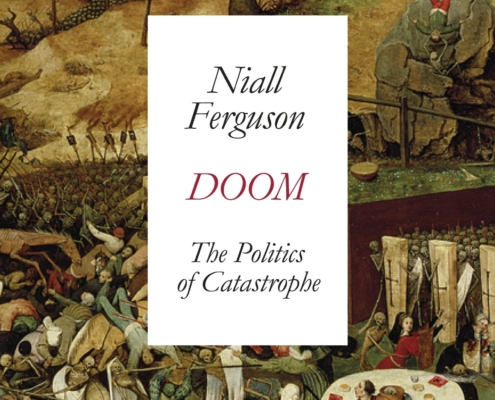
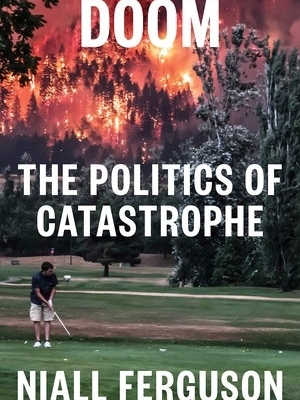
 On October 24, 1986 (35 years ago this week), the American comedy
On October 24, 1986 (35 years ago this week), the American comedy 
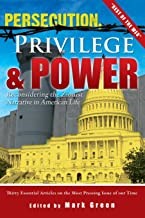
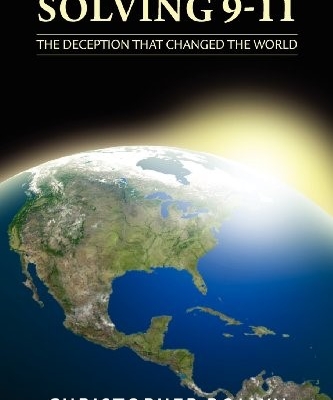
 Lucian Freud’s portrait, “Benefits Supervisor Sleeping”
Lucian Freud’s portrait, “Benefits Supervisor Sleeping”
